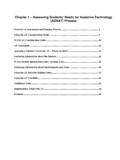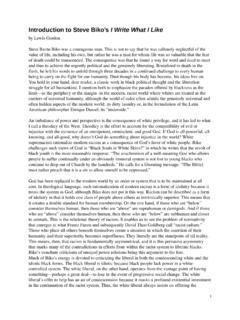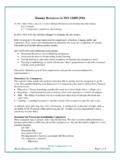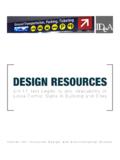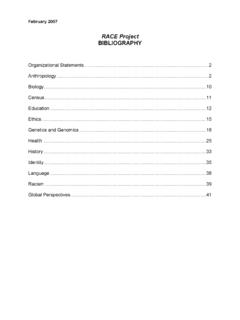Transcription of Chapter 12 - Assistive Technology for Students …
1 Chapter 12 - Assistive Technology for Students who are Blind or Have Low Vision Introduction ..1 Using the SETT Process and the Decision Making Guide ..2 Decision Making Guide ..3 Decision Making Guide Expanded ..4 Assistive Technology Continuum ..9 Assistive Technology Supports organized by visual impairments ..10 Tools for Transition ..17 Tools for Accommodations ..18 Assessments ..19 Vision Built-in Vision Accessibilities Windows, Mac, Linux ..21 Free Resources ..22 Products for Low Vision ..24 Products for Blindness and CVI.
2 25 Solution Selection Tools and Strategies ..28 Testimonials ..29 Useful Resources ..29 Text Formats ..29 Assessing Students Needs for Assistive Technology (2009) 1 Chapter 12 Assistive Technology for Students who are Blind or have Low Vision Assistive Technology for Students who are Blind or have Low Vision Jaroslaw Wiazowski, This Chapter intends to provide information regarding a process for evaluating the Assistive Technology of Students who are blind or have low vision.
3 Assistive Technology advances at a quick pace, requiring ongoing research and awareness on the part of the practitioner. The reader will find a list of low- and high- Technology devices that offer Students access to the academic curriculum as well as extra-curricular activities. Although the focus of this information is on assisting Students who are blind or have low vision, these tools may also be helpful for many Students with other disabilities. Included are specifically designed tools to assist Students both in accessing and processing curriculum.
4 It is important to understand the necessity of teaching the underlying skills needed to be independent in the use of Assistive Technology , which can be equally valuable in classrooms and community. For example, Braille notetakers are useful not only for note taking in class, but also for composing and printing essays, writing notes, send e-mails, or browsing the Internet. Assistive Technology can give Students who are blind or have low vision support in all academic areas as well as in expanded core curriculum. The selection of devices is contingent upon a variety of factors.
5 To begin the process of consideration, the student s vision condition needs to be identified. Additional information should be acquired regarding the Students appropriate media format through the learning media assessment. For the purposes of this information visual impairment is divided into three major categories low vision, functional blindness/blindness, and cortical (cerebral) visual impairment. Each of these groups has specific characteristics that will govern the selection of appropriate Assistive tools. Visual Impairments Defined Group Description Low Vision An ocular condition where a person s visual acuity ranges from 20/70 to 20/200 (legally blind) after best correction, or visual field subtends the angle of 50 degrees or less.
6 Functional Blindness/Blindness An ocular condition where a person perceives light or less, or is unable to efficiently use their residual vision. Cortical (Cerebral) Visual Impairment A neurological condition related to the visual pathway where a person has difficulty in interpreting visual information. Assessing Students Needs for Assistive Technology (2009) 2 Chapter 12 Assistive Technology for Students who are Blind or have Low Vision Using the SETT Process and the Decision Making Guide The SETT process is designed to establish those characteristics in order to recommend the best possible solutions.
7 The SETT process considers several factors that influence the choice of tools, devices, and interventions. It is imperative that the student s strengths and weaknesses are known. The needs assessment also considers the environment in which the student receives instruction. It is also important to know about the student s plans after high school graduation. When all of the above information is gathered, conclusive decisions can be made. It is worth mentioning that in some cases more than one solution may be implemented to obtain desired results.
8 The process of decision-making about Assistive Technology can be complex and inexact, making it difficult to match one tool with a specific area. For example, to give a student with low vision better access to print, either a large print book, or regular print book with some type of magnifier can be provided. Assessing Students Needs for Assistive Technology (2009) 3 Chapter 12 Assistive Technology for Students who are Blind or have Low Vision WATI Assistive Technology Decision Making Guide Area of Concern.
9 Vision PROBLEM IDENTIFICATION Student s Abilities/Difficulties Environmental Considerations Tasks Print size Reading visual or tactile medium Illegible handwriting Navigating the computer operating system and programs Identifying & finding details in pictures Touch typing Need for audio enhancement Color blindness Photosensitivity Activities of daily living Participation in gym activities Organization Physical or motor-related issues Desk space Classroom space Location in the room Visual access of board work Visual access of classroom presentations Type of learning medium Type of light and level of illumination External noises Assistive Technology : past and present Reading Writing Note-taking Large group distance presentations Visual activities Computer-assisted tasks Converting print into electronic format Activities of daily living Gym activities Sensory Considerations Narrowing the Focus What sensory challenges does the student have that impacts learning?
10 ( , visual, auditory, tactile) Identify Specific task(s) for Solution Generation Solution Generation Tools & Strategies Solution Selection Tools & Strategies Implementation Plan Brainstorming only No decisions yet Review solutions in respect to type of visual impairment and the area that requires additional support. Use a feature match process to discuss and select ideas(s) from Solution Generation AT trials/services needed: Formulate specific task objectives to determine effectiveness of trial: Training needed Date Length Person(s) Responsible Follow-Up Plan Who & When Set specific date now.
